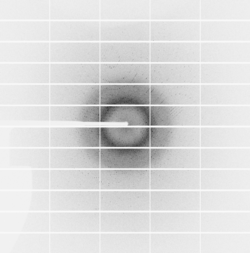Physics:Pilatus (detector)

Pilatus is the name of a series of silicon pixel detectors developed at the Swiss Light Source, and commercialised by Dectris. The common factor is that X-rays are converted to an electrical signal by the photoelectric effect in silicon subject to a substantial bias voltage, and then counted directly by a series of cells in an ASIC bonded to the silicon detector, rather than relying on a phosphor. That is, each pixel has its own amplifier, discriminator (for distinguishing X-rays of the desired energy from noise) and counter circuit; this is possible because the desired pixel size for X-ray crystallography is around 100 micrometres, and a 100 micrometre square in a contemporary CMOS process can contain a significant quantity of electronics.
Design challenges include making the bonding of the ASIC to the sensor sufficiently reliable; the ASIC has to be manufactured in a radiation-tolerant process since the sensor layer by no means absorbs all the incident X-rays.
Other issues involve combining ASICs to make a sensor of usable size - protein crystallography applications tend to want an active area of around 100,000 mm², though powder diffraction work can use a rather smaller active area. One detector inclines the ASICs so that the view from the point of view of the crystal is of an unbroken sphere of detector.
This article uses only URLs for external sources. (2021) (Learn how and when to remove this template message) |
This article does not cite any external source. HandWiki requires at least one external source. See citing external sources. (2021) (Learn how and when to remove this template message) |

